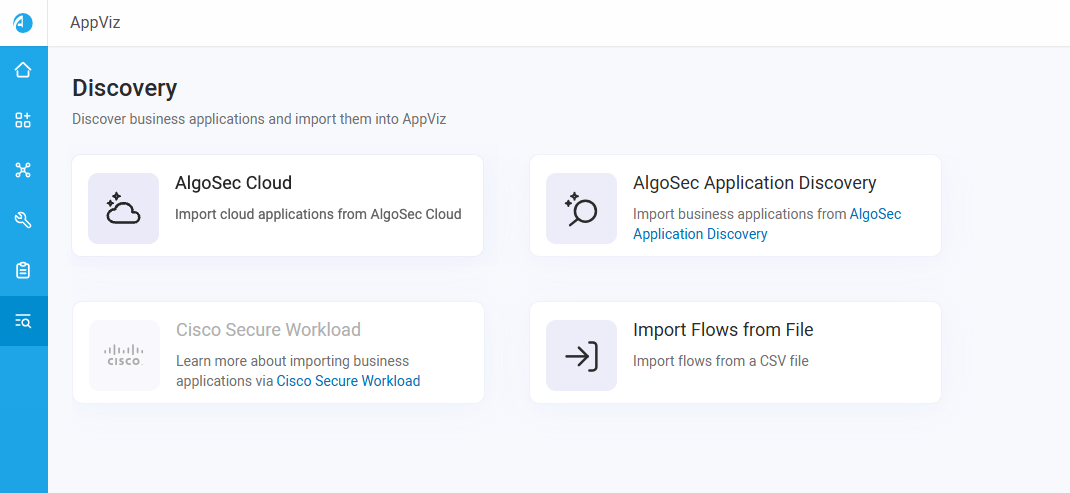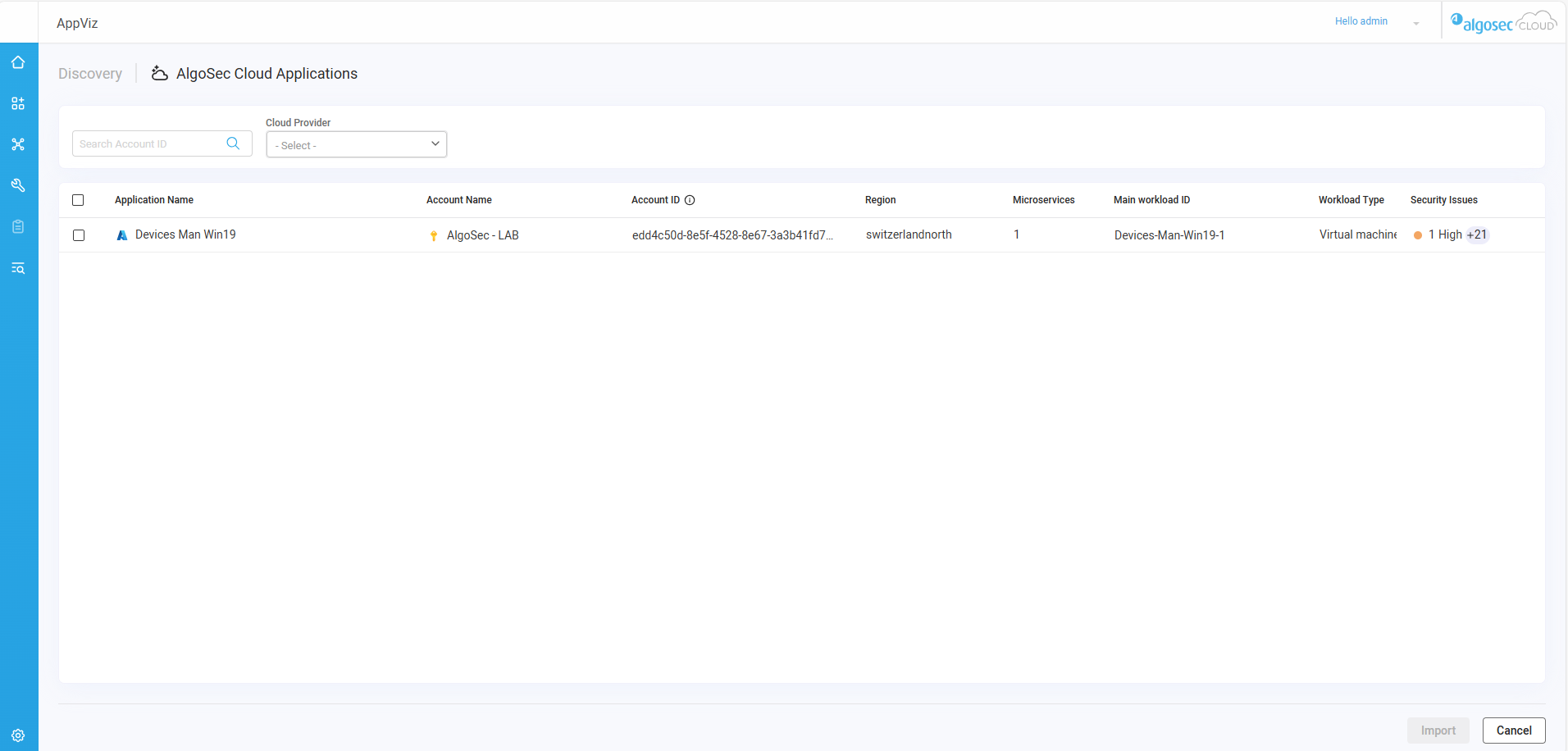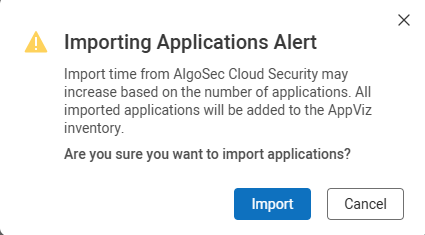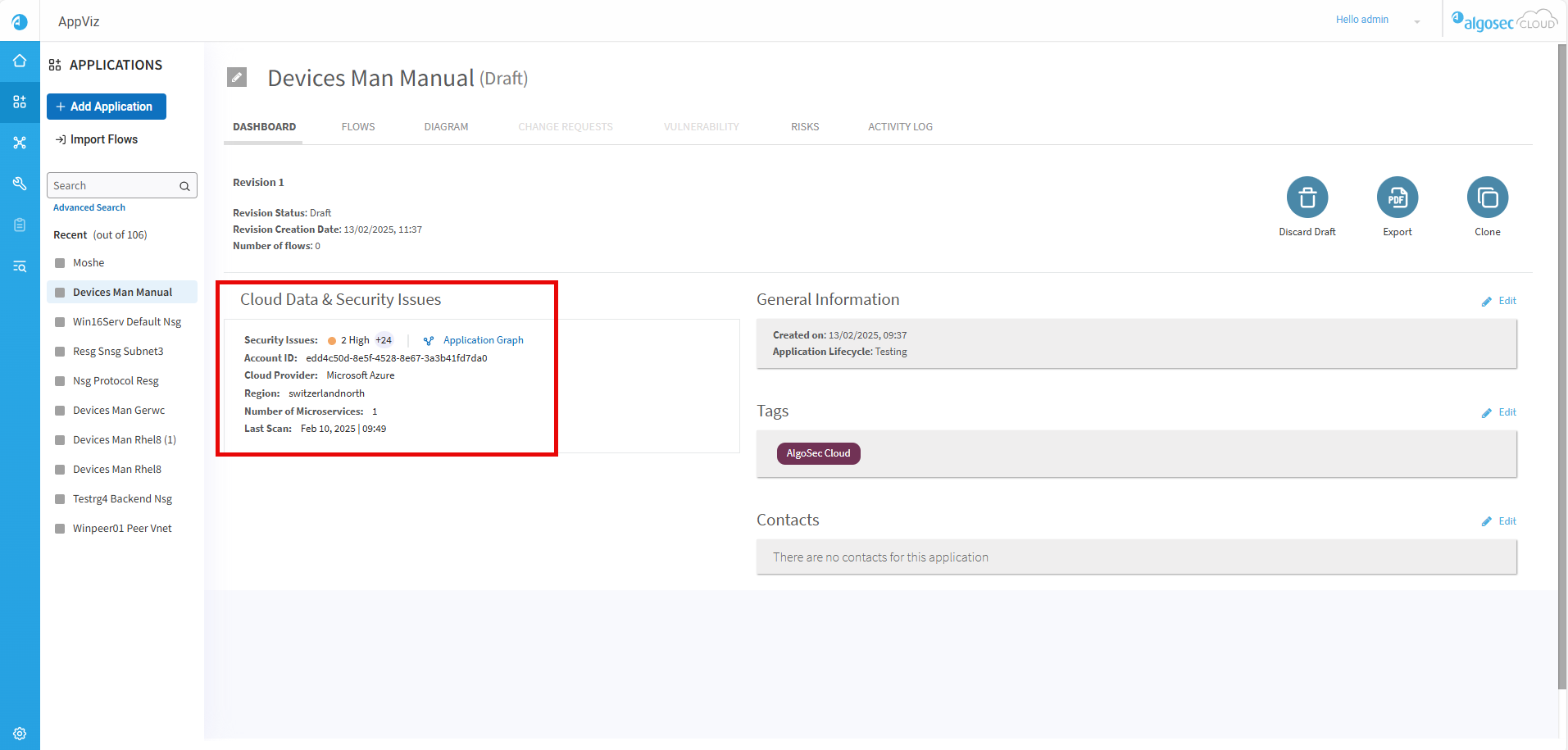This topic describes how to discover business applications and import them and their flows into AppViz.
Import discovered applications
You can import discovered business applications from the following sources:
 AI-Driven Application Discovery (recommended) AI-Driven Application Discovery (recommended) |
Imports applications from AFA and FireFlow Leverage AI to identify and suggest applications to add to AppViz, making the discovery process faster and more intelligent. AI-Driven Discovery is the simplest and recommended way get started to build your applications library. For further information, see AI-Driven Application Discovery in AppViz. |
| AlgoSec Application Discovery |
Imports applications from onprem network traffic and Azure network traffic Discover applications and flows using a configured AlgoSec Application Discovery server. For further information, see Import applications from Application Discovery & Cisco Secure Workload . For information about Application Discovery, see Welcome to Application Discovery. |
 AlgoSec Cloud (ACE Cloud App Analyzer) AlgoSec Cloud (ACE Cloud App Analyzer) |
Imports applications from cloud resources Import cloud applications discovered by the ACE Cloud App Analyzer. For further information, see Import applications discovered by ACE Cloud App Analyzer. |
| Cisco Secure Workload (Tetration) |
Imports applications from Cisco Secure Workload Discover applications and flows using a configured Cisco Secure Workload (formerly known as Tetration) server. For further information, see Import applications from Application Discovery & Cisco Secure Workload . Note: For more details about Cisco Secure Workload, see Configure a Cisco Secure Workload server |
| Import Flows from File |
Import flows from a prepared CSV file. This is especially helpful when exporting flows from AFA, where you can use the policy as stored in AFA to create the CSV file. See Import application flows to AppViz from a File. |
 Import applications discovered by ACE Cloud App Analyzer
Import applications discovered by ACE Cloud App Analyzer
Do the following:
-
In AppViz, click DISCOVERY from the navigation menu on the left, and then click the discovered application source AlgoSec Cloud.
The AlgoSec Cloud Applications page appears.
Note: The applications that appear in the list are based on the data collected from the last daily sync with Cloud App Analyzer.
-
 (Optional) Sort and filter applications to quickly find specific applications.
(Optional) Sort and filter applications to quickly find specific applications.
-
Sort: To sort by Application Name, Account Name, Region, or Microservices, click on its column name.
-
Filter:
The built-in search and dropdown fields are as follows:
Field Description Search -
Enter partial or full text to search the following information:
-
Application Name
-
Account Name
-
Account ID
-
Region
-
Workload Name
-
Workload Type
-
-
Click on a specific search result to show its details in the list of applications, or press Enter to populate the list with all matching search results.
Application Name Select one or more application names.
Security Issues Select one or more security issues.
Add additional filters
You can add additional filters to filter applications based on data from other columns.
Do the following:
-
-
Manage columns: To hide or show columns, click
 and use the checkboxes to select the columns to display. Application Name, Region, App Graph, and Security Issues cannot be hidden. Click Reset View to show all of the columns.
and use the checkboxes to select the columns to display. Application Name, Region, App Graph, and Security Issues cannot be hidden. Click Reset View to show all of the columns.
-
-
Select the application(s) you want to import into AppViz .
-
Click Import.
-
Click Import to finalize the import. The application is imported to AppViz .
When an application is imported in this manner from ACE Cloud App Analyzer, it is assigned the “AlgoSec Cloud” tag. Additionally, in the Application Dashboard, a “Cloud Data & Security Issues” section appears, displaying information about the application from ACE Cloud App Analyzer. This section also provides a link to open the application’s graph in ACE Cloud App Analyzer. See Cloud Data & Security Issues.
Import applications from Application Discovery & Cisco Secure Workload
Do the following:
-
In AppViz, click DISCOVERY from the navigation menu on the left, and then click the discovered application source:
-
AppViz starts pulling discovered applications from the selected source.
For applications discovered via Application Discovery or Secure Workload (Tetration): Results are displayed in a table with the following columns:
Discovered applications The name of the business application discovered via Application Discovery or Secure Workload (Tetration). # of connections The number of connections found for the discovered application.
AppViz applications The AppViz application mapped to the discovered application. The default AppViz application name is the name of the discovered application.
- If an AppViz application already exists with the same name, any newly discovered flows are added to the existing AppViz application.
- If no AppViz application is found with the same name, a new AppViz application is created.
 Edit the mapped AppViz application name
Edit the mapped AppViz application name
To edit the name assigned to the AppViz application by default, do the following:
- Click
 next to the AppViz application name.
next to the AppViz application name. -
Either select another existing application from the dropdown list, or click
 to clear the current value and enter a new name.
to clear the current value and enter a new name.If you enter a new name, click Create new .... under the text box to confirm the name.
For example:

- Click the
 to save your changes.
to save your changes.
-
Click Next to continue.
AppViz displays a summary of the applications and flows that AppViz will import or create.
A list of flows is collapsed under each relevant AppViz application. Click the arrows (
 and
and  ) to expand or collapse the flows.
) to expand or collapse the flows.Note: If your system is configured to optimize traffic flows, the flows are displayed after optimization. This means you'll have a lower count of flows than what AppViz originally detected. For more details, see Configure advanced discovery settings.
Tip: By default, all AppViz applications and flows are selected for import. Clear the checkbox next to each application or flow that you do not want AppViz to create at this time.
-
Click Import. AppViz starts importing the selected applications and flows.
When complete, AppViz displays the results of any applications imported successfully, partially, or if any applications failed. For example:

- Click Finish to return to the main Discovery page.
The new applications are listed in the APPLICATIONS area in AppViz, and will be synchronized with AFA as configured.
Import application flows to AppViz from a File
This section describes how to import application flows from a CSV file to AppViz with flow optimization.
You can import application flows via a CSV file that is generated in AFA (see Export rules as flows to AppViz), or you can create you own file.
If you want to import flows without flow optimization, see Import flows.
Note: During the import process:
-
If an entity in the CSV file is not found, AppViz creates a suitable network object with the details from the CSV in order to ensure a successful import.
-
AppViz attempts to optimize the imported flows to help organize and manage applications more effectively.
Do the following:
-
[Optional step about optimizing]
-
In AppViz, click DISCOVERY from the navigation menu on the left, and then click the discovered application source:
-
Click Import Flows from File.
-
Download an example CSV file, if needed. Edit it as required. For more details, see Update data via CSV files
-
If you are working in AFA, export flows directly from the AFA Policy tab. For details, see Export rules as flows to AppViz Export rules as flows to AppViz .
-
-
Click Select File to browse and select the file to import.
-
AppViz displays a summary of the applications and flows found. If AppViz failed to import many lines, you may have a small
 at the end of the line. Click the small
at the end of the line. Click the small  to expand the list fully.
to expand the list fully.To continue with your import, click Next. [This simulates the application and attempts to optimize the flows.]
-
Use the checkboxes to the left of each flow to select which flows to import into AppViz.
[insert screenshot]
-
Click Import.




